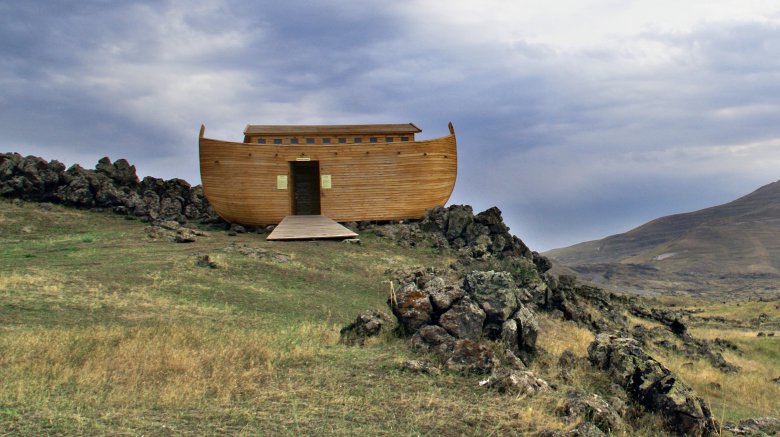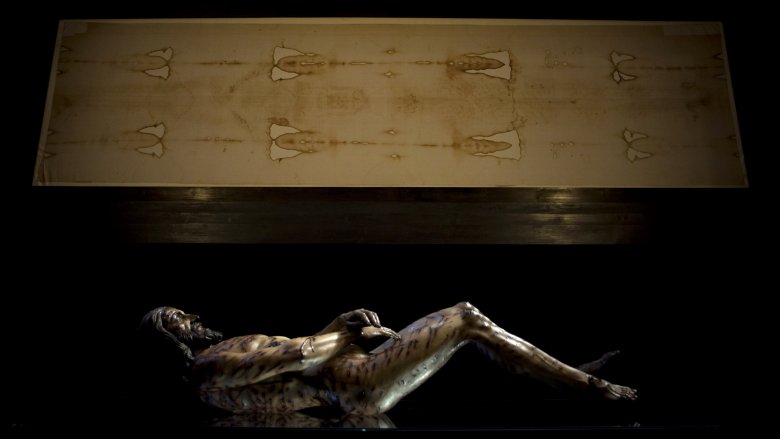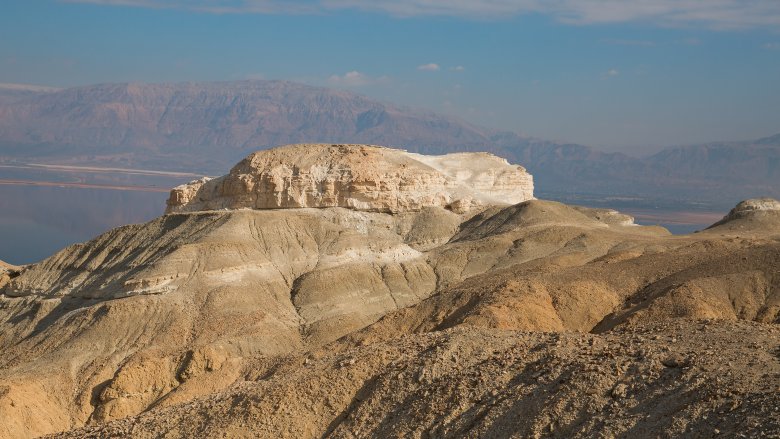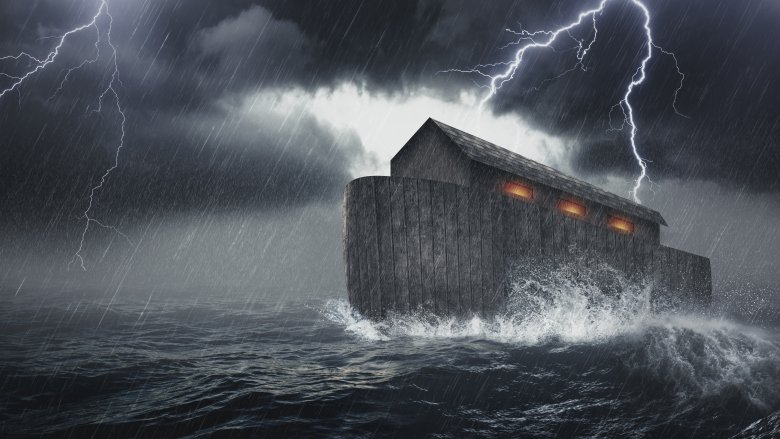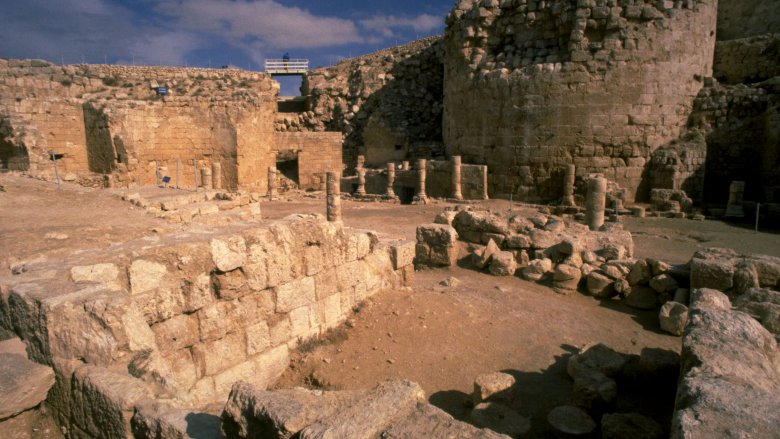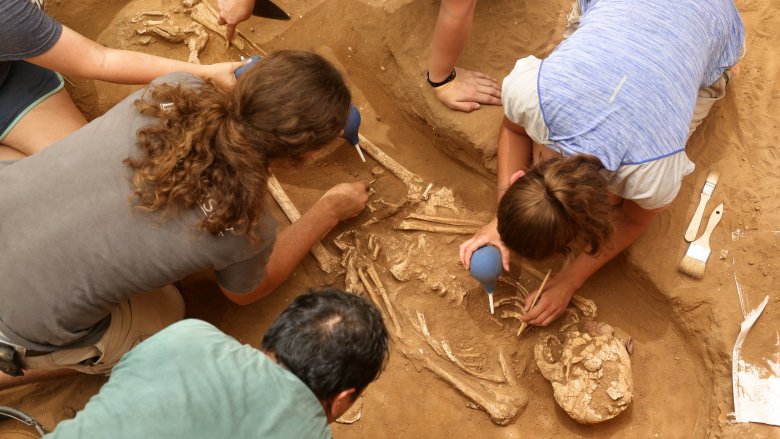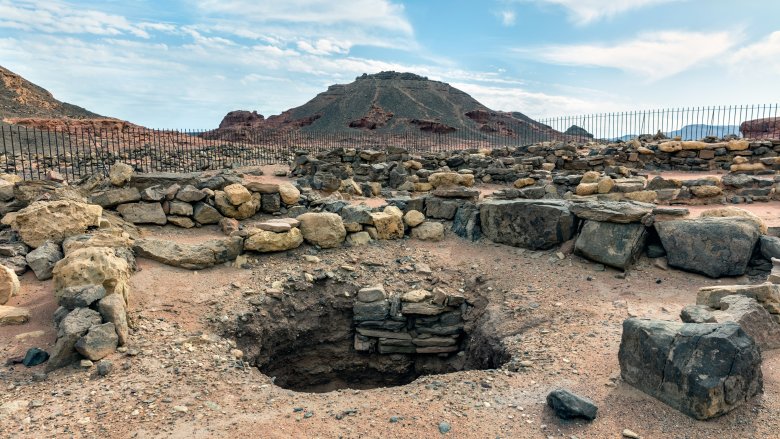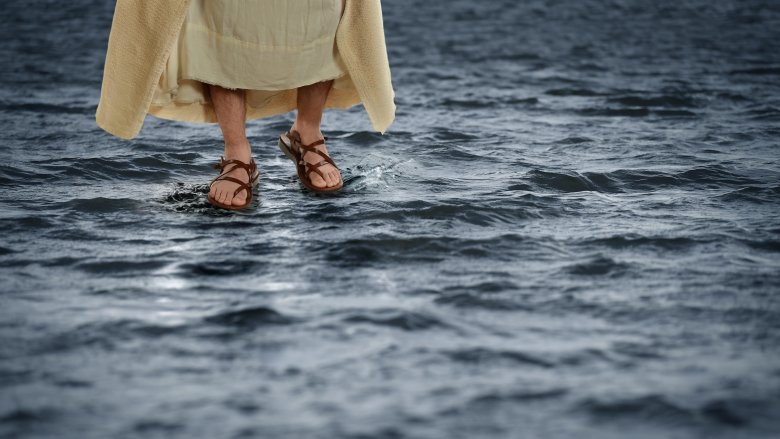Bible Mysteries That We've Finally Solved
The Bible is full of mysterious questions we don't know the answers to, and there are entire Bible plotlines that just up and disappeared. When you're dealing with the supernatural, it's very difficult to prove anything, by its very nature. Faith doesn't depend on scientific explanations, and plenty of people are happy to believe what the Bible says, either literally or figuratively, and not worry about the earthly reality of it all.
But others want to dig deeper. There are many scientists, archaeologists, historians, and more who have applied their expertise to some of the questions the Bible raises. Not all of them hit the jackpot, but every now and then their research pans out, and we can say a biblical mystery is solved. Okay, sure, you can never really solve a puzzle from thousands of years ago 100 percent for sure, but for these particular Bible mysteries, it's reasonably fair to say that answers have maybe/possibly/probably been found.
Is the Shroud of Turin for real?
Two of the gospels mention Jesus' body being wrapped in a shroud before he was buried. As with any Biblical item, people have been desperate to locate this cloth. The most famous candidate today is the Shroud of Turin.
According to History, the Shroud first showed up in 1354. The Cathedral of St. John the Baptist got it in 1578, but it wasn't until major scientific advances in the 1970s that tests on its age were arranged. Radiocarbon dating would prove once and for all if the Shroud had the slightest chance of being real. Between deciding who would do the tests, making sure there was no bias either way, and advancing techniques even more so only a small sample was needed, the experiment was delayed until the 1980s. Finally, in 1989, the scientists released their findings in the journal Nature. They concluded with 95 percent certainty that the Shroud of Turin was medieval, dating between 1260 and 1390. This coincides with when it suddenly appeared in 1354, and the science was sound. That settled it for most people, including the Vatican, which refers to the Shroud as an "icon" (more like religious art) and not a "relic" (the real deal).
If that's not enough, another study in 2018 found the bloodstains on the Shroud are probably fake because the scientists were "unable to find a single position [of a body] in which the blood flowed onto experimental cloths to create the stain pattern."
Was Sodom a real place?
If you're not up on modern Biblical interpretation, you probably think of Sodom (half of the Sodom and Gomorrah double act) as a city full of crazy sins. These days scholars think Sodom's biggest no-no was just being inhospitable to some angels, but the bigger question is whether this place even existed at all. It's hard for any sins of the bedroom variety or otherwise to go down if the town wasn't a real location. As with most things in the Old Testament, you have to take Sodom with a huge grain of salt.
That might have changed in 2015. According to Popular Archaeology, a team had been doing excavations in a place now known as Tall el-Hammam in Jordan for 10 years. After all that time, they had plenty of evidence that the location fit the biblical description of Sodom. It was the largest city on a "well-watered plain" in Jordan, surrounded by smaller settlements. Described as "monstrous" in size, the city had a booming population, serious fortifications, a palace, temples, government administration buildings, all the signs of a flourishing society. It also had access to lots of water and lay on various important trade routes.
But perhaps most surprising is that this metropolitan marvel came to a "sudden, inexplicable end." The archaeologists discovered that toward the end of the Middle Bronze Age, Tall el-Hammam/maybe Sodom abruptly became a wasteland for 700 years. Could that be the destruction described in the Bible? It's very possible.
Was there really a Great Flood?
Noah and the Great Flood is one of the most famous stories in the Bible. Was there really a flood that covered the entire world? No. But was there a seriously catastrophic flood in a localized area that killed tons of people and was probably a huge part of the inspiration for this story? Yes.
Underwater archaeologist Robert Ballard has seriously legit credentials. ABC News reports in 1985 he led the team that found the wreck of the Titanic. When Ballard heard a theory that thousands of years ago a massive flood formed the Black Sea as we know it today, he was intrigued. As the last ice age ended, huge glaciers all over the world started melting. The Mediterranean Sea grew full to bursting. The theory says eventually the water exploded over the strip of land where Istanbul is today and rushed into the Black Sea, which was only a small freshwater lake at the time. The force of the water was "two hundred times that of Niagara Falls" and destroyed everything in its path.
Ballard went looking for evidence and found that 400 feet below the surface of the Black Sea was an ancient shoreline. About 37,000 acres of land, and everything on it including people and animals, seems to have been wiped out very quickly about 5,000 years ago. The event would have remained in people's minds and been passed down, eventually ending up in the Bible in a story that tried to make sense of the catastrophe.
Where was Jesus condemned to death?
You can't just start building things in Jerusalem. There's so much history under the ground that experts need to come in and dig around before new stuff can go up. (As one archaeologist put it, "Jerusalem is like an onion. You peel it, peel it, peel it, and it never ends.") Sometimes, they find cool stuff. And that's what happened in 1999, reports the Washington Post. Plans to expand the Tower of David Museum turned up an amazing find: the remains of Herod's palace.
Herod appears in the beginning of Jesus' story, when the Magi rock up and ask where to find the baby. But he was long dead by the time Jesus is tried in front of Pontius Pilate. According to one archaeologist, it's "only logical" that Pilate would stay in the dead king's palace when he dropped by Jerusalem since it had plenty of luxury and facilities. If Pilate conducted business in Herod's palace, that means it's where Jesus was tried in praetorium and eventually sentenced to die.
Jewish Magazine says evidence supporting this discovery includes tedious archaeological details like how blocks are cut and a previously excavated water drain. While it might not sound like much, the find has been described as important for "Christians who care about accuracy in regard to historical facts." A professor added that with everything we now know about Herod's palace, the "archaeological, historical and gospel accounts — all falls into place and makes sense."
Were the Philistines really that bad?
These days, we call someone a philistine if they're totally uncultured and don't appreciate the arts, like everyone who bought Truck Nutz. But in the Bible, they were also a people to be feared. The Independent says the Philistines were the Israelites' archenemy. Their crimes included seizing the Ark of the Covenant, the Philistine Delilah cutting off Samson's hair, and being uncircumcised. The most famous conflict came in the middle of a war between the two sides when a young not-yet-king named David knocked out the fearsome giant Goliath with a rock and then cut off his head.
Since the Jews got to write the book about what happened, the Philistines don't come off looking great. Fortunately, they have archaeologists on their side. A 30-year dig at Ashkelon National Park in Israel unearthed the first known cemetery of the Biblical bad guys.
What they found was that at least when it came to burying their dead, the Philistines were far from philistines. The dig unearthed men buried with their weapons. Some bodies were still wearing beads, bracelets, earrings, and toe rings, and there were also decorated jugs that would have contained scented oil, wine, or food. Based on their burial practices, there are signs the Philistines lived a "cosmopolitan life" that was "elegant and worldly" and connected to the rest of Mediterranean society. One archaeologist told NPR, "There wasn't a period where we don't see them loving art and sophistication and decoration." Not so bad after all.
How did the Sun stand still?
Some crazy stuff happens in Joshua 10. Basically, a king wants to attack an Israeli ally, and Joshua gets concerned, but God says, don't worry, I got this. The king's army is destroyed, with lots of slewing and smiting. As the defeated force runs away, there's this weird line: "Joshua said to the Lord in the presence of Israel, 'Sun, stand still over Gibeon, and you, moon, over the Valley of Aijalon. So the sun stood still, and the moon stopped." Readers of the Bible have wondered what exactly that meant for ages. How could the Sun stand still?
According to the Smithsonian, 100 years ago, one linguist thought he had the answer. The Hebrew word "dôm," usually translated as "stopped moving," should really be interpreted as "stopped shining." This could indicate that an eclipse occurred during the battle. If it was one, the passage in Joshua would be the first ever written record of the phenomenon. But for the next century after this theory emerged, no one could pinpoint a total solar eclipse at a time and place that made sense.
Until 2017, that is. That's when some researchers decided to look for an annular eclipse — one where the Sun isn't completely covered. They narrowed the timeframe by comparing the Old Testament information with an Egyptian source that mentions the Israelites. The researchers found an annular eclipse occurred in the right area on October 30, 1207 B.C., and it could very well be what the Biblical writer was trying to describe.
How did King Solomon and the Queen of Sheba get so rich?
In 1 Kings 10, the queen of Sheba comes to see King Solomon. Ostensibly she's there because she heard how wise he is and wants to test him, but the writer seems to just want to compare how stupidly rich the two are. The queen arrives with a huge caravan weighed down under tons of gold and precious gems. Plus, she gives Solomon the biggest gift of spices ever. But it's not like he was hard up. The chapter also tells how Solomon had more riches than any other king, including gold and silver, nice clothes, thousands of horses, and a really over-the-top ivory and gold throne.
So if these two people existed (and that's not a sure thing), how did they get so stinking rich? Vast copper mines in Israel were known about for hundreds of years, according to Live Science. But in 2013, an excavation discovered that the mines were "definitely" from the period of King Solomon. Radiocarbon dating of artifacts showed they lined up perfectly with his reign. While that doesn't mean he owned the valuable mines, the Bible describes a battle for control over the area, and the mines might have been why.
As for the queen of Sheba, the Guardian says an excavation in 2012 found an ancient gold mine in what would have been her territory. It's marked with the sign of Sheba and there are inscriptions carved in the language she spoke. The mine is extensive and could have easily made her wealthy.
What killed King Herod?
The Gospel of Matthew says that when King Herod learned about the birth of baby Jesus, he didn't take it well. He decided to kill all the baby boys in the region hoping to take out the alleged son of God, but Jesus' family escaped to Egypt. The last we hear about Herod is Matthew 2:19, with the very illuminating piece of information that "Herod died."
Unlike many people mentioned in the Bible, there's no question King Herod was a real person. He's usually known as Herod the Great, and the BBC says historians agree he had a "hugely successful reign." (There's no proof outside the Bible that he ordered the killing of all those babies, so historians aren't being complete sickos.) Like all real people, Herod did indeed die. The 2,000-year-old question was, what killed him?
According to UPI, ancient sources record something went seriously wrong, with Herod developing "intense itching, painful intestinal problems, convulsions in every limb and gangrene of the genitals." It's so weird the Bible omitted that last detail. In the past, scholars thought maybe the king had a seriously bad case of gonorrhea, but this didn't really completely explain his issues. In 2002, medical researchers decided to tackle the question as part of the Clinical Pathological Conference. The experts' conclusion was Herod died of "chronic kidney disease, complicated by an unusual infection of the genitals" called Fournier's gangrene. While it's impossible to be completely sure they diagnosed him correctly, all the pieces seem to fit. This mystery may be solved.
What caused the plagues in Egypt?
When the pharaoh in Exodus refuses to let the Jewish slaves go, Moses brings down holy hell on Egypt. The 10 plagues God sent include the Nile turning to blood, infestations of pests like flies and locusts, weird weather and darkness, and sickness and death for both humans and animals. While there's a lot of debate if any of the events in Exodus really happened, scientists proved the plagues aren't as unlikely as you might think.
It all comes down to the combination of global warming and a volcanic eruption, according to the Telegraph. In 2010, climatologists found there was a dramatic shift in the Egyptian climate during the end of Ramses II's reign. (While it's not known who the pharaoh in Exodus is, many historians think it's that guy.) There was a sudden dry period after decades of rainy weather. Rising temperatures would have dried up the Nile, turning it into a slow-moving stream. The stagnant water would have attracted a certain type of algae that made the water look red (like "blood"). Toxic algae causes frogs to reproduce faster, so they would suddenly have been everywhere. When the frogs died, insects flourished. An epidemic of mosquitoes carrying disease could have sickened livestock and people, killing bunches of them.
As for the hail storms and darkness, the eruption of Thera 3,500 years ago spewed ash everywhere and could have resulted in massive storms and blocked out the Sun. It even brought on conditions that locusts love. It all fits.
How did Moses part the Red Sea?
The plagues might be possible, but Moses parting the Red Sea is a lot less realistic on its face. The story goes that when the pharaoh finally cries uncle after the 10 plagues, Moses and the Jewish slaves leave. But God makes the pharaoh change his mind and he sets out to bring them back. To escape, Moses stretches out his hands and God "caused the sea to go back by a strong east wind." The Jews cross the now-dry land and escape Egypt.
Can wind, God-controlled or not, actually push back water like that? According to the Washington Post, software engineer Carl Drews looked into this for his masters thesis. His findings were reported in the peer-reviewed journal PLOS One in 2010, plus his employer, the National Center for Atmospheric Research, promoted his conclusions. It turns out "impeccable science" shows parting the Red Sea was totally possible.
The first key is where it happened. Today, the original Hebrew is usually translated as the Red Sea, but it more accurately means "Sea of Reeds." Archaeologists have identified this was probably the Lake of Tanis, a "shallow brackish lagoon." "Shallow" being the key word. An atmospheric event called a "wind setdown," basically a gust at 60 mph, would have been strong enough to push the water away and leave dry land. This is something that's actually been observed in places like Lake Erie and the Nile Delta. Drews says his results show faith and science can be compatible.
How did Jesus walk on water?
In the gospels, Jesus wanders around miracling the crap out of everything. He raises a guy from the dead, heals the sick, and famously at one point in Matthew, he walks on water. Then the disciples got on a ship, but Jesus took some me time and went to pray. When he was finished, the ship was already in the middle of the sea, but he took this in stride and started walking toward it.
How was that possible? If you believe Jesus was the son of God, it has a pretty simple explanation. Or you can reject the whole story outright and say it never happened. But some scientists figured out a way it would be doable, even without holy intervention.
According to Live Science, in 2006, the scientists did a study and published their findings in the Journal of Paleolimnology. They discovered that under very specific conditions, ice formed in what is now Lake Kinneret. While you'd never get freezing conditions there today, there were two notable cold snaps, including when Jesus was alive. There's an area where salt springs flow into the freshwater lake, and this would have enabled the freezing. The floating patch of ice just below the surface would have been hard for onlookers to see, especially if it had rained recently, and it could have supported a human. So while Jesus walking on water could be either a miracle or a tall tale, it's also possible it actually happened for perfectly scientific reasons.
